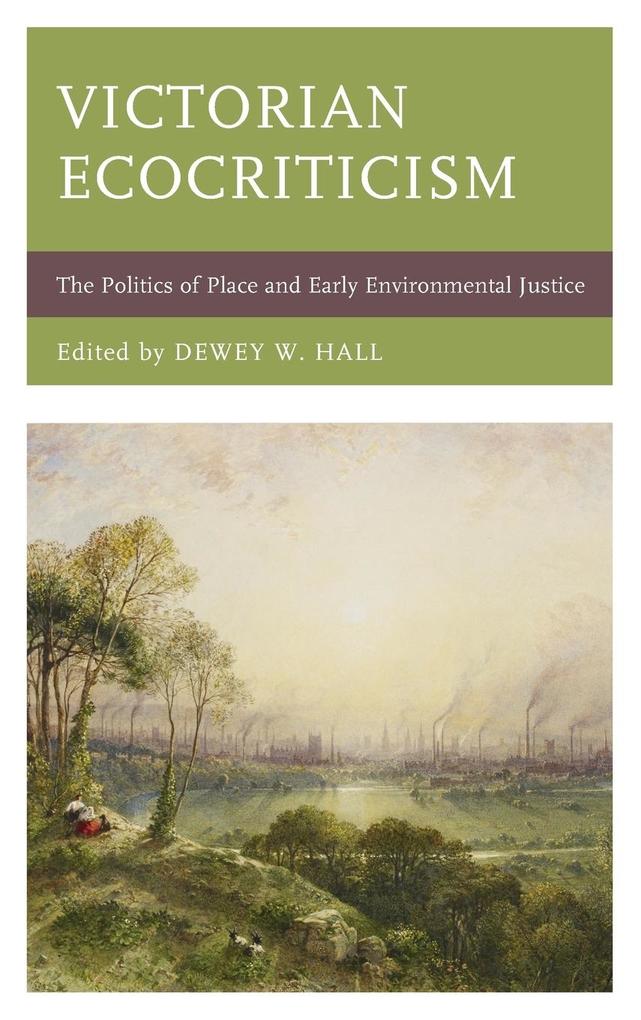
Zustellung: Mo, 05.05. - Do, 08.05.
Versand in 1-2 Wochen
VersandkostenfreiBestellen & in Filiale abholen:
Victorian Ecocriticism: The Politics of Place and Early Environmental Justice aims to take up the challenge that Lawrence Buell lays out in The Future of Environmental Criticism: Environmental Crisis and Literary Imagination (2005). Buell decries: "For in order to bring 'environmental justice into ecocriticism,' a few more articles or conference sessions won't suffice. There must be 'a fundamental rethinking and reworking of the field as a whole'" (Buell 113). While discussions about nature conservation and preservation have been important within the context of ecocriticism, Buell asserts that the holy grail for the field is actually how literary critics engage in discourse about questions of place as space humanized for the purpose of tracing, disclosing, and advancing the important issue of environmental justice-as it applies to human beings, animals, and plants. The "fundamental reworking" or shift in the field of Victorian Studies really has to do with the dearth of ecocritical publishing about seminal authors and literary texts. Victorian Ecocriticism aims to participate in filling that vacuum, lack, or lacuna by featuring current research about the Victorian era from an ecocritical perspective.
Victorian Ecocriticism hopes to identify, establish, and organize its content based on six themes: Ecocrisis, Ecofeminism, Ecogothicism, Ecohistoricism, Ecotheology, and Ecological Interdependence. The edited collection, thus, has two aims. First, selected places among others featured in the edition will provide environmental contexts, often with political implications: American rural landscape (e. g. , Walden Pond), Australian mines, British hill-country, metropolis, mill towns, the sea, and the woods. Second, the edition includes discussions about various instances of early environmental justice evident during the mid-nineteenth century such as, but not limited to: anti-railway campaigns, biological egalitarianism, labor disputes due to adverse working conditions, patterns of displacement, reactions to Victorian scientism, resistance to enclosure, and working class education.
Victorian Ecocriticism is an interdisciplinary edition. It focuses on Victorian literature as the foundational discipline linked to various disciplines such as ecology, evolutionary biology, natural history, and soil science. The topics are wide-ranging, significant, and contemporary discussing the politics of place as well as early environmental justice.
Victorian Ecocriticism hopes to identify, establish, and organize its content based on six themes: Ecocrisis, Ecofeminism, Ecogothicism, Ecohistoricism, Ecotheology, and Ecological Interdependence. The edited collection, thus, has two aims. First, selected places among others featured in the edition will provide environmental contexts, often with political implications: American rural landscape (e. g. , Walden Pond), Australian mines, British hill-country, metropolis, mill towns, the sea, and the woods. Second, the edition includes discussions about various instances of early environmental justice evident during the mid-nineteenth century such as, but not limited to: anti-railway campaigns, biological egalitarianism, labor disputes due to adverse working conditions, patterns of displacement, reactions to Victorian scientism, resistance to enclosure, and working class education.
Victorian Ecocriticism is an interdisciplinary edition. It focuses on Victorian literature as the foundational discipline linked to various disciplines such as ecology, evolutionary biology, natural history, and soil science. The topics are wide-ranging, significant, and contemporary discussing the politics of place as well as early environmental justice.
Inhaltsverzeichnis
Foreword by Laura Dassow Walls
Part One: Place in the British Isles
Chapter 1
Introduction: The Matter of Place-Consciousness
Dewey W. Hall
Chapter 2
Railways, Tourism, and Preservation in the Victorian Lake District: from Wordsworth to Rawnsley
Saeko Yoshikawa
Chapter 3
Wending Homeward: The Material Turn in Charlotte Brontë's Jane Eyre
Adrian Tait
Chapter 4
Hard Times: Factory Education, Factory System, and the Preston Strike
Dewey W. Hall
Chapter 5
The Politics of Place Attachment and the Laboring Body in Thomas Hardy's Tess of the d'Urbervilles
Jillmarie Murphy
Part Two: Place in Australia, Newfoundland, and America
Chapter 6
Antipodal Ecology: Colonial Landscaping in Victorian Fiction
Julie M. Barst
Chapter 7
Ecotheological Morality in Charles Kingsley's The Water-Babies
Akemi Yoshida
Chapter 8
Philip Henry Gosse, Newfoundland, and the Unveiling of Wonders
Sue Edney
Chapter 9
Seeing Soils
Marlee Fuhrmann
Chapter 10
"Different shades of green": Elizabeth Gaskell's EcoGothic Short Fictions
Michelle Deininger and Natalie Rose Cox
Part One: Place in the British Isles
Chapter 1
Introduction: The Matter of Place-Consciousness
Dewey W. Hall
Chapter 2
Railways, Tourism, and Preservation in the Victorian Lake District: from Wordsworth to Rawnsley
Saeko Yoshikawa
Chapter 3
Wending Homeward: The Material Turn in Charlotte Brontë's Jane Eyre
Adrian Tait
Chapter 4
Hard Times: Factory Education, Factory System, and the Preston Strike
Dewey W. Hall
Chapter 5
The Politics of Place Attachment and the Laboring Body in Thomas Hardy's Tess of the d'Urbervilles
Jillmarie Murphy
Part Two: Place in Australia, Newfoundland, and America
Chapter 6
Antipodal Ecology: Colonial Landscaping in Victorian Fiction
Julie M. Barst
Chapter 7
Ecotheological Morality in Charles Kingsley's The Water-Babies
Akemi Yoshida
Chapter 8
Philip Henry Gosse, Newfoundland, and the Unveiling of Wonders
Sue Edney
Chapter 9
Seeing Soils
Marlee Fuhrmann
Chapter 10
"Different shades of green": Elizabeth Gaskell's EcoGothic Short Fictions
Michelle Deininger and Natalie Rose Cox
Mehr aus dieser Reihe
Produktdetails
Erscheinungsdatum
16. Oktober 2017
Sprache
englisch
Seitenanzahl
212
Reihe
Ecocritical Theory and Practice
Herausgegeben von
Dewey W. Hall
Verlag/Hersteller
Produktart
gebunden
Gewicht
465 g
Größe (L/B/H)
235/157/16 mm
ISBN
9781498551069
Bewertungen
0 Bewertungen
Es wurden noch keine Bewertungen abgegeben. Schreiben Sie die erste Bewertung zu "Victorian Ecocriticism" und helfen Sie damit anderen bei der Kaufentscheidung.


































